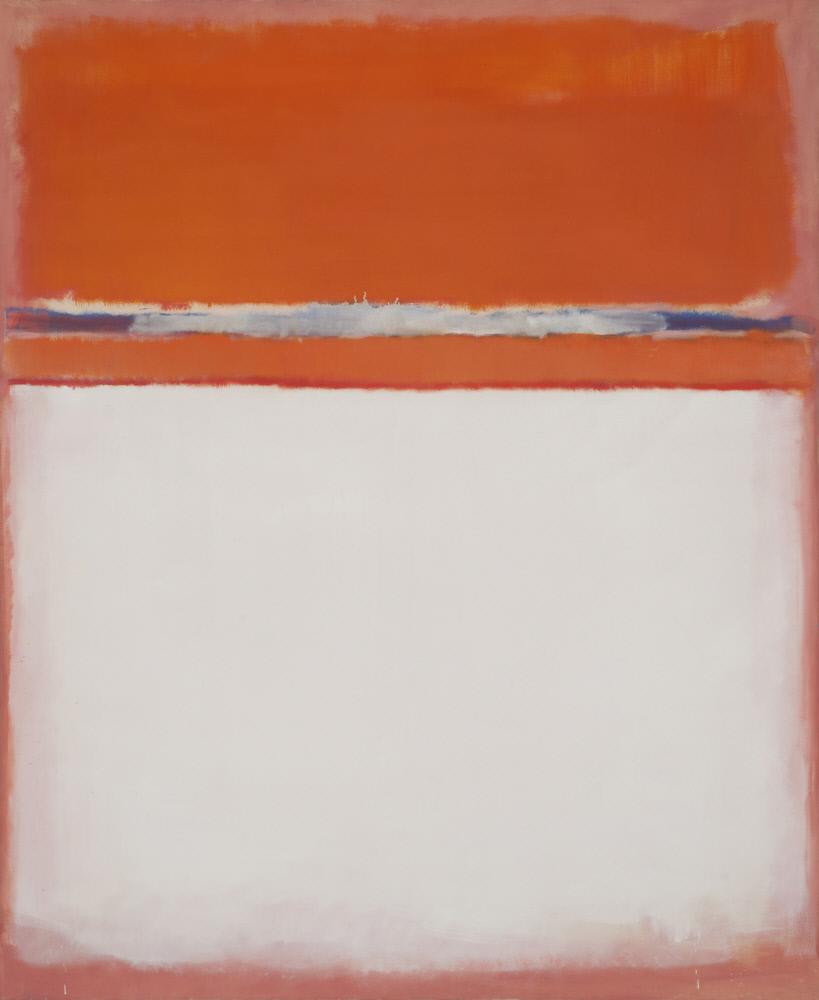Emotion Through Painting vs. Painting Through Emotion
by Madeline Justiniano ’21
Pollock and Rothko might be men of the same artistic movement, but they prioritize different things in their artwork. The difference between Rothko and Pollock is that Rothko uses the paint to bring to life his and the viewers emotions, meanwhile Pollock uses his emotion to bring life to the paint itself.

When looking at a Rothko painting, it is easy for the casual viewer to reduce the painting to a couple geometric shapes in solid colors. However, a longer study of Number 18 reveals a liminality, a fuzziness to the edges of these geometric zones that is intentional. The painting pulls the viewer in, invites them through a doorway of cream to a sunset of orange viewed from a forest of black shadows. All of this is my projection of representation on a non-representational work, but it shows the success of Rothko. Rothko wants the viewer to feel moved and have an emotional reaction, and if the emotional reaction also provokes a creative interpretation, so be it. Abstraction doesn’t necessarily preclude a representational interpretation, but seems so open ended as to maybe even encourage the viewer to fill in the blanks with their own truths,
Number 18 is imposing, and it is the canvas’s large stature that prevents the painting from fading into the background. A lot of contemporary decorative art is modelled after Rothko and I believe the reason why is the unique ability of a Rothko painting to define a space. The soft cream and bright tangerine simultaneously soothe and embolden the viewer respectively, lending to the focused atmosphere of the room. The brush strokes are large and softened and despite the geometric nature of the painting’s shapes, there are no truly straight lines. They are rough-hewn and naturalistic. There is little ambivalence in this painting. It asks the viewer to emote vibrantly, just as its vibrant colors hit the cones of a viewer’s retina.

There is no subject matter to a painting by Pollock other than the process of the painting itself. Number 2 is a painting about the arduous, desperate act of painting. His large gestures, his physical sweat, they are all present in the painting itself. He uses his intuition and emotional feeling to guide him in allowing the paint to drip and splatter all over the canvas. Those drips are each eye catching and entrancing. There is so much more intricate and erratic detail that a viewer can fixate on in a Pollock as compared to a Rothko. That does not mean that there is more or less visual interest, but that the viewer is drawn to individual flecks or curving arcs more readily than to broad, flat brush strokes and subtle shifting between larger color fields.
Despite the initially perceived erratic and unsystematic approach of Number 2, the viewer finds themselves pondering the order in which he applied drippings, the decisions he made to utilize one color paint more frequently than others, how he made certain shapes occur, etc. The most important mark of the artist is not the content of the painting, but the process of making the painting which comes to life before your eyes. The bright white paint especially brings out this relationship of the piece to time. It is layered over a dark maroon background and under a few red splotches. It probably took the longest to drizzle and was the most difficult for Pollock to fully tame. Other colors appear more sporadically, and with more control and restraint exerted. Paint is not a medium that likes to be held back, but he manages to maintain order in a chaotic microcosm. There are rules to this painting, not ones that have any logic, rhyme or reason other than the aesthetic sense of Pollock and his intuitive knowledge of how the paint would like to live on this canvas. He used his emotional connection to the painting to guide him, and that is how he achieved his nonsensical sense of order.
Looking at these two paintings, I believe Pollock and Rothko would have loved what each other did with color, but they had very different approaches that determined what was most important to convey to the viewer through the medium of paint: the magic of the process vs. the sublime.